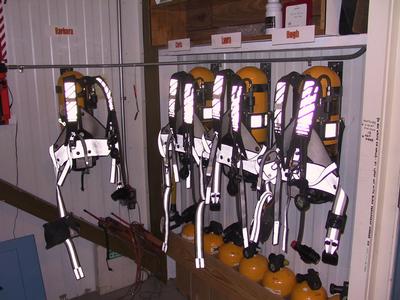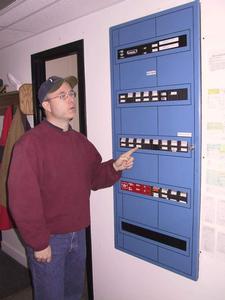5 February, 2002
THE FIRE DRILL !!!
Last week we had a fire drill. These drills take place
every month, but it is a surprise when one happens. The Palmer Station
doctor writes up a situation or scenario. She goes around putting signs on
places, such as "this door is hot", or "this room is full of smoke". Then
she pulls the fire alarm.
Twelve members of the support staff went to fire school in Colorado before
they came to Palmer Station. The school has a special training that has been
developed for the Palmer site. This is an unusual place, because high winds
would make firefighting difficult. Also, we don't have professional
firefighters anywhere nearby. The fire school teaches the Palmer team how
to do a search and rescue for people trapped in buildings. The main way we
fight fires here, however, is by prevention of fires in the first place. We
are very concerned about safety. No one can have candles, cigarettes, or
fires of any kind in their rooms.
There is a fire marshal and three "first responders". When the fire alarm
sounds, these three responders go to the main alarm panels to see where the
fire alarm was set off. Then these people go to the problem area to see
what is happening. If it is a small fire, they are to put the fire out.
Otherwise, they report by radio what they have found, and the SCBA team
comes in.
When the fire alarm sounds, the "Self-Contained Breathing Apparatus" (SCBA)
team members jump into their special clothing. There are six people on
these teams. They need to be able to get into their clothing in less than 2
minutes and show up at their staging area in 3-4 minutes from the first
alarm. They are ready to put on their air tanks if they need to do so.
Meanwhile, all the rest of us must drop whatever we are doing and go quickly
to the Boathouse. This is our "muster area". A person there reads off our
names, so that she knows if anyone is missing. We could hear the first
responders and the rescue team talking on the radio. It sounded very
realistic, and at first some of us thought there was a real fire!
For this drill, two people had been chosen in advance to be "missing", and
one of them was the Fire Marshal! So, the assistant fire marshal had to
leap into action. The two "victims" were trapped in a smoke-filled room.
(Remember, all this was just practice-there were signs to tell the rescue
team what the situation was.) The SCBA team had to go into the room with
their air tanks on. They had to talk to each other by radio while wearing
their breathing masks.
One of the "victims" was very aggressive and loud. The rescue team had a
challenge to get him out of the building and onto a stretcher. When the
drill was over, the team talked about what had happened and what they had
learned. I didn't take any photos during the drill, so afterwards I went
around the station to take the images you see here.

There are fire extinguishers and oxygen packs in many places around Palmer Station.

There are fire hoses in many places around Palmer Station. This one is inside the BioLab building.

This is the fire suppression water tank. It holds 9,000 gallons of fresh water. It is hard to tell the size of this, but look at the steps and railing. Imagine a person standing there, and you will know that this is a very large tank.

These are the air tanks for SCBA team members Barbara Watson, Chris Vitry, Laura Hamilton, and Hugh MacMullan.

The boots are already in the overalls. All the team members must do is step into their boots and pull up the suspenders!

Bob Farrell, Station Manager, stands beside one of the fire alarm panels. Bob is also the Fire Marshal for Palmer Station.

These are the clothes for SCBA team members Laura Hamilton and Hugh MacMullan. They have two sets of clothes. The clothes are in two different places at Palmer Station. When the alarm sounds, they go to the closest place to dress.
Contact the TEA in the field at
.
If you cannot connect through your browser, copy the
TEA's e-mail address in the "To:" line of
your favorite e-mail package.
|
